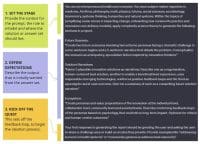How can an outline be awesome? When it helps you write more efficiently and more effectively. Think of an outline as a care plan for your article. You use care plans to promote optimal patient outcomes. Similarly, an outline promotes optimal writing outcomes. As prolific author and psychologist Silvia states, “People who write a lot outline a lot.”
Outlining may seem like a throwback to high school English class, but it can serve as a useful writing tool. Here’s how to create an effective outline.
Start with a summary statement
What’s the purpose of your article? Whom do you want to read it? Answers to these questions form the basis of the summary statement, which lives up to its name: It’s a statement that summarizes the article.
Here’s an example:
This article tells medical/surgical nurses how to identify a patient with pulmonary embolism (PE) by assessing clinical presentation, diagnostic test results, and differential diagnoses.
Note that the statement specifies nurses in the medical/surgical specialty as opposed to another specialty such as home care or critical care. An article on PE for those nurses would differ in some areas. For example, for home care nurses, you might want to add teaching patients at risk what they should do if they experience signs and symptoms of PE.
The summary statement serves as your guide throughout the outlining (and writing) process. If the content doesn’t fit with the summary statement, it shouldn’t be in the article. For instance, this article doesn’t plan to address PE treatment.
Write a draft
Good articles are like good stories: They have a beginning, middle, and end. Keep that in mind as you think about what you want to include in your article. Write down each major section. Sometimes it helps to define each section a bit more, as illustrated by the questions below:
- Introduction (Why is this topic important?)
- Clinical presentation (How does the patient with PE present?)
- Diagnostic tests (What results indicate PE?)
- Differential diagnoses (What else could this be?)
- Conclusion (What are two or three key points nurses should remember?)
Once you have your draft, you may realize you need (or want) to reorganize the order. For instance, you might decide to put differential diagnoses before diagnostic tests because certain tests might be used to rule out different conditions.
Flesh it out
Once you have your major headings, flesh out the outline to create a map for writing your article. Roman numerals (Arabic numbers can be used if you prefer) correspond to the main sections of the article. Traditionally, letters and then numbers are used to designate subsections and further subsections of the main section, but I think it’s easier to use bullet points and sub-bullets, as shown here:
I. Introduction (Why is this topic important?)
- Open with case situation to bring reader into article
- Need for prompt diagnosis
II. Clinical presentation (How does the patient with PE present?)
- Relevant history
- Signs and symptoms
- Abrupt onset of pleuritic chest pain, shortness of breath, hypoxia, anxiety
- May have atypical or no symptoms
- Physical examination
- Common findings (tachypnea, tachycardia, fever, rales, heart sound abnormalities)
III. Diagnostic tests (What results indicate PE?)
- Laboratory tests
- D-dimer testing
- Arterial blood gases
- Serum troponin level
- Imaging studies
- Computed tomography angiography
- Pulmonary angiography
- Chest radiography
- ECG
- Magnetic resonance imaging
- Echocardiography
IV. Differential diagnoses (What else could this be?)
- Myocardial infarction
- Acute pericarditis
- Fat embolism
- Atrial fibrillation
- Other
V. Conclusion (What are two or three key points nurses should remember?)
- Hallmark signs and symptoms
- Importance of nurses in prompt diagnosis
- Outcome of case situation
Expand as needed
Before you start writing, take another look at the outline to verify that it’s congruent with your summary statement and that it includes everything you need. You may want to add notes about figures and tables you want to include, as indicated below in blue:
III. Diagnostic tests (What results indicate PE?)—Table of tests and what each is used for
- Laboratory tests
- D-dimer testing
- Arterial blood gases
- Serum troponin level
- Imaging studies
- Computed tomography angiography—Image showing PE
- Pulmonary angiography
- Chest radiography
- ECG
- Magnetic resonance imaging
- Echocardiography
IV. Differential diagnoses (What else could this be?)—Table of diagnoses that highlights features unique to each condition
- Myocardial infarction
- Acute pericarditis
- Fat embolism
- Atrial fibrillation
- Other
Your outline should be detailed enough to give you a solid grasp of how your article will be organized and what it will include. As you gain more writing experience and get more comfortable with mentally outlining articles, your written outlines may become shorter. However, even the most experienced author can benefit from an outline of key points so the article’s organization is clear from the start.
Ready to go
With outline in hand, you’re ready to write! Sometimes you may need to tweak your outline as you realize the transition from one topic to another doesn’t work as planned. However, having an outline helps you avoid the time you waste when you realize after completing the article that it doesn’t flow or you have omitted key information. All good writing requires revision, but an outline will help you reduce the time needed for this task.
References
Dwyer Schull P, Saver C. Finding, refining, and defining a topic. In: Saver C. Anatomy of Writing for Publication for Nurses. 4th ed. Indianapolis: Sigma Theta Tau International; 2021; 21-30.
Silvia PJ. How to Write a Lot: A Practical Guide to Productive Academic Writing. Washington, DC: American Psychological Association; 2007.
 Hi, I’m Cynthia Saver, MS, RN, president of CLS Development, Inc., which provides writing and editing services, and editor of Anatomy of Writing for Publication for Nurses, 4th ed. I’m also past editorial director for American Nurse Journal.
Hi, I’m Cynthia Saver, MS, RN, president of CLS Development, Inc., which provides writing and editing services, and editor of Anatomy of Writing for Publication for Nurses, 4th ed. I’m also past editorial director for American Nurse Journal.
I’ve been a full-time professional nurse writer and editor for many years, and that doesn’t count the writing I did as I fulfilled my nursing roles in clinical, research, education, and management. My passion is helping nurses share their expertise through the written word, including, but not limited to, publication. Writing can be scary and intimidating. I hope to make it less so and to help you develop your writing skills the same way you’ve developed your nursing skills.
Whether you’re considering your first or your 50th publication, want to contribute to your organization’s newsletter, or crave to be a better communicator online and in print, I hope you’ll find what I write helpful. The nurse publishing colleagues I’ve learned from over the years (many of whom are contributors to my book) may not be listed by name, but I’m grateful for their willingness to share. In that spirit, I’m looking forward to sharing with you! If you have feedback, feel free to email me at csaver57@gmail.com.



















